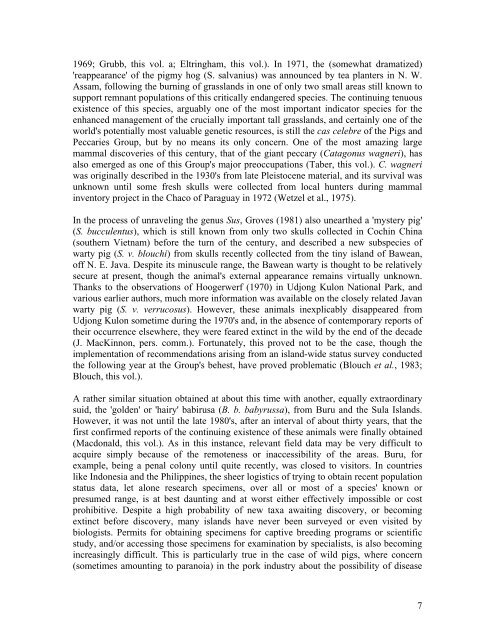The Afrotropical Suids - IUCN
The Afrotropical Suids - IUCN
The Afrotropical Suids - IUCN
Create successful ePaper yourself
Turn your PDF publications into a flip-book with our unique Google optimized e-Paper software.
1969; Grubb, this vol. a; Eltringham, this vol.). In 1971, the (somewhat dramatized)<br />
'reappearance' of the pigmy hog (S. salvanius) was announced by tea planters in N. W.<br />
Assam, following the burning of grasslands in one of only two small areas still known to<br />
support remnant populations of this critically endangered species. <strong>The</strong> continuing tenuous<br />
existence of this species, arguably one of the most important indicator species for the<br />
enhanced management of the crucially important tall grasslands, and certainly one of the<br />
world's potentially most valuable genetic resources, is still the cas celebre of the Pigs and<br />
Peccaries Group, but by no means its only concern. One of the most amazing large<br />
mammal discoveries of this century, that of the giant peccary (Catagonus wagneri), has<br />
also emerged as one of this Group's major preoccupations (Taber, this vol.). C. wagneri<br />
was originally described in the 1930's from late Pleistocene material, and its survival was<br />
unknown until some fresh skulls were collected from local hunters during mammal<br />
inventory project in the Chaco of Paraguay in 1972 (Wetzel et al., 1975).<br />
In the process of unraveling the genus Sus, Groves (1981) also unearthed a 'mystery pig'<br />
(S. bucculentus), which is still known from only two skulls collected in Cochin China<br />
(southern Vietnam) before the turn of the century, and described a new subspecies of<br />
warty pig (S. v. blouchi) from skulls recently collected from the tiny island of Bawean,<br />
off N. E. Java. Despite its minuscule range, the Bawean warty is thought to be relatively<br />
secure at present, though the animal's external appearance remains virtually unknown.<br />
Thanks to the observations of Hoogerwerf (1970) in Udjong Kulon National Park, and<br />
various earlier authors, much more information was available on the closely related Javan<br />
warty pig (S. v. verrucosus). However, these animals inexplicably disappeared from<br />
Udjong Kulon sometime during the 1970's and, in the absence of contemporary reports of<br />
their occurrence elsewhere, they were feared extinct in the wild by the end of the decade<br />
(J. MacKinnon, pers. comm.). Fortunately, this proved not to be the case, though the<br />
implementation of recommendations arising from an island-wide status survey conducted<br />
the following year at the Group's behest, have proved problematic (Blouch et al., 1983;<br />
Blouch, this vol.).<br />
A rather similar situation obtained at about this time with another, equally extraordinary<br />
suid, the 'golden' or 'hairy' babirusa (B. b. babyrussa), from Buru and the Sula Islands.<br />
However, it was not until the late 1980's, after an interval of about thirty years, that the<br />
first confirmed reports of the continuing existence of these animals were finally obtained<br />
(Macdonald, this vol.). As in this instance, relevant field data may be very difficult to<br />
acquire simply because of the remoteness or inaccessibility of the areas. Buru, for<br />
example, being a penal colony until quite recently, was closed to visitors. In countries<br />
like Indonesia and the Philippines, the sheer logistics of trying to obtain recent population<br />
status data, let alone research specimens, over all or most of a species' known or<br />
presumed range, is at best daunting and at worst either effectively impossible or cost<br />
prohibitive. Despite a high probability of new taxa awaiting discovery, or becoming<br />
extinct before discovery, many islands have never been surveyed or even visited by<br />
biologists. Permits for obtaining specimens for captive breeding programs or scientific<br />
study, and/or accessing those specimens for examination by specialists, is also becoming<br />
increasingly difficult. This is particularly true in the case of wild pigs, where concern<br />
(sometimes amounting to paranoia) in the pork industry about the possibility of disease<br />
7












